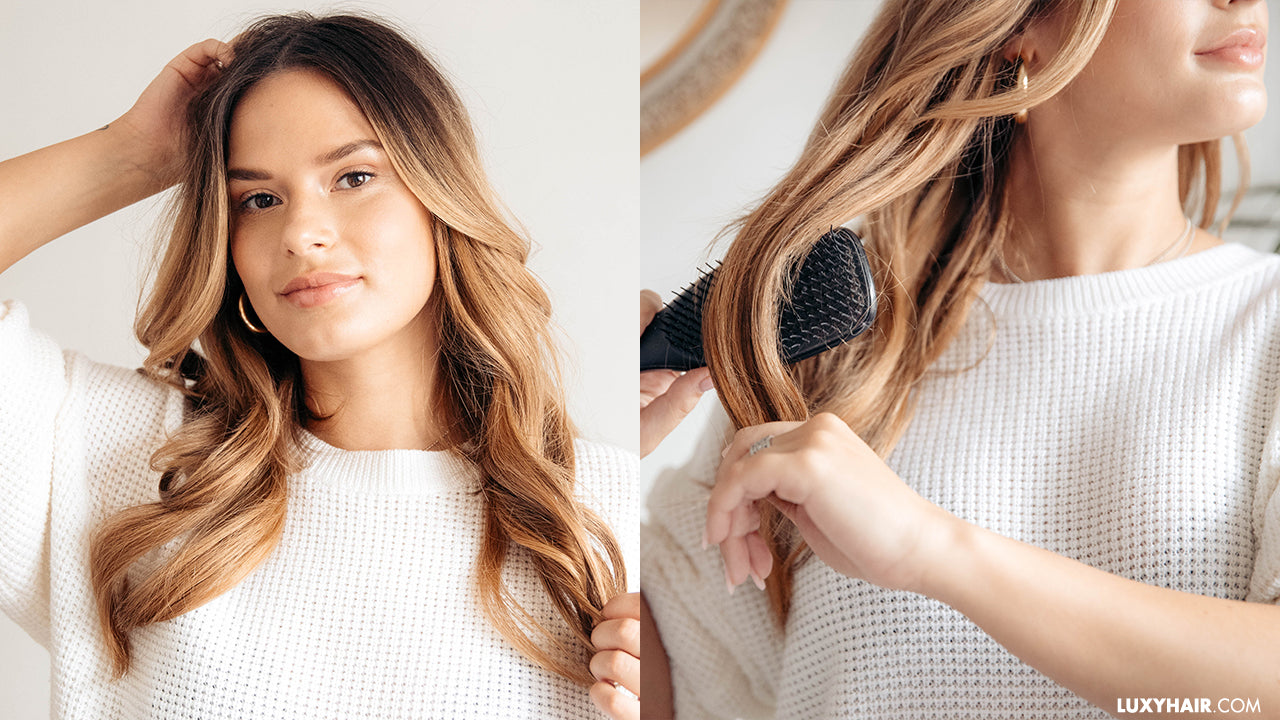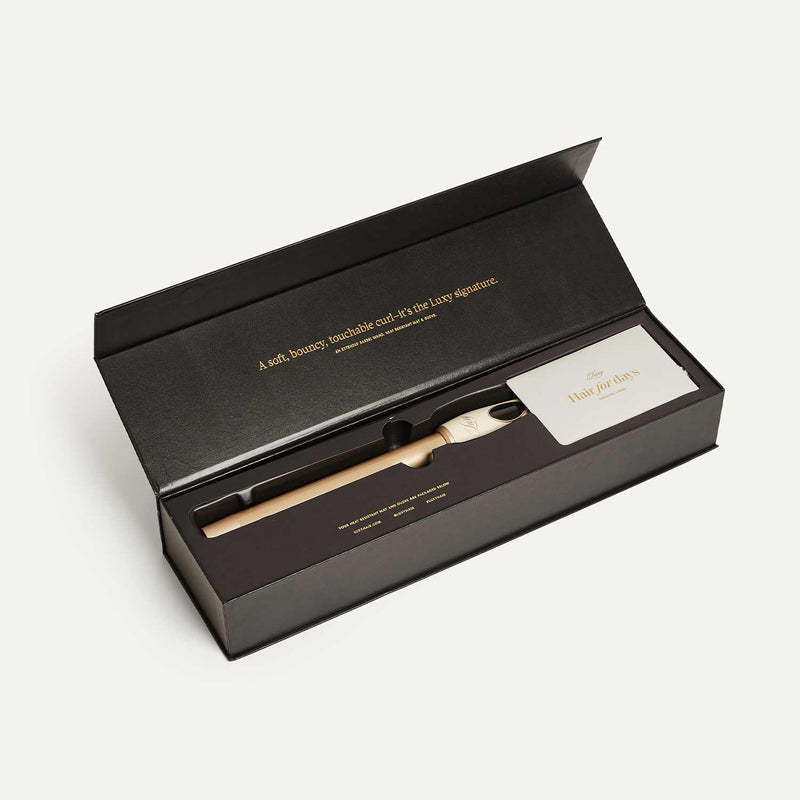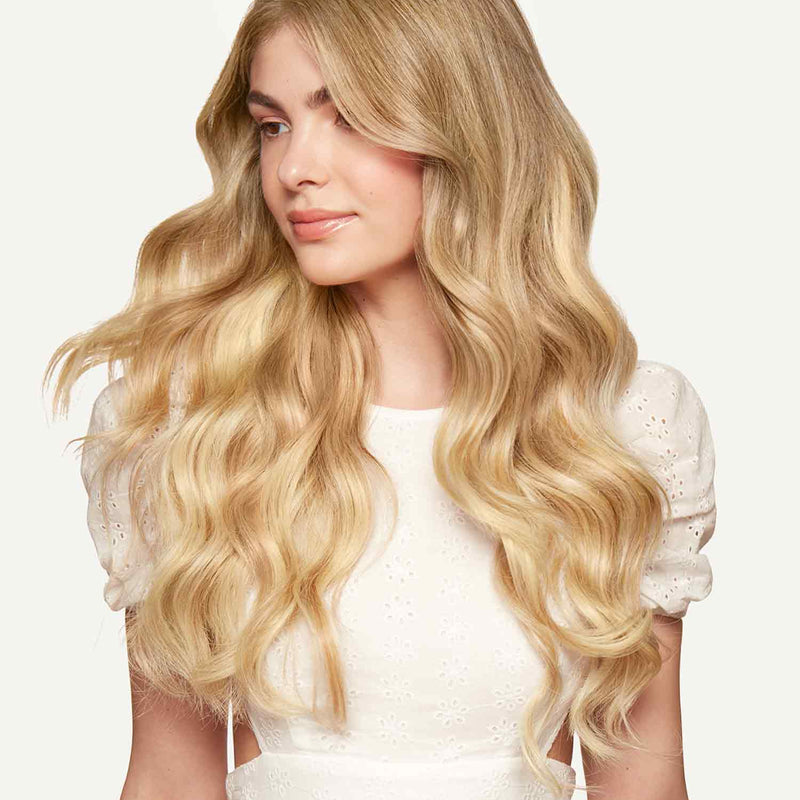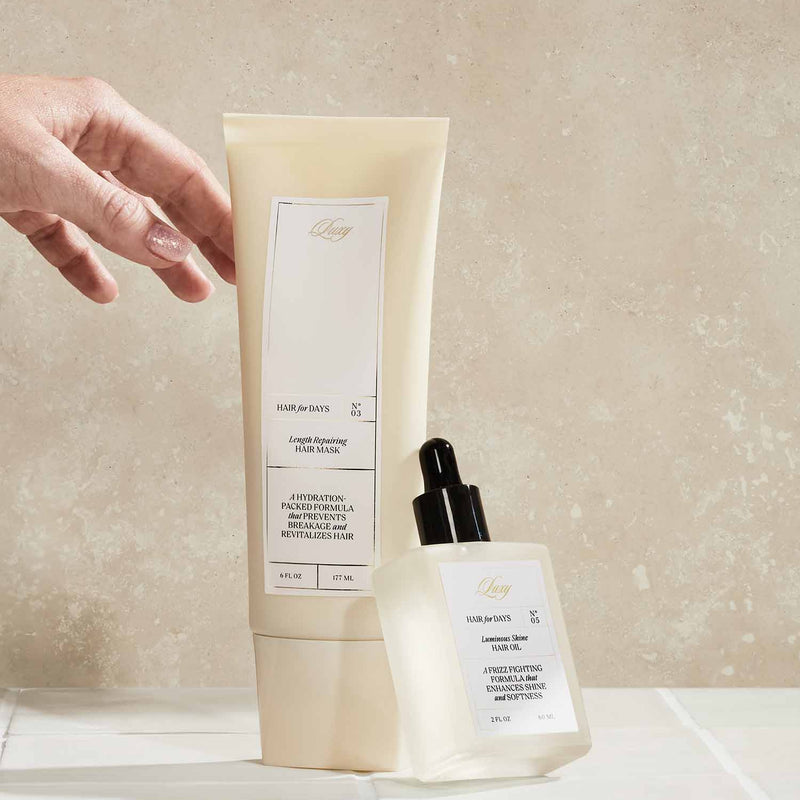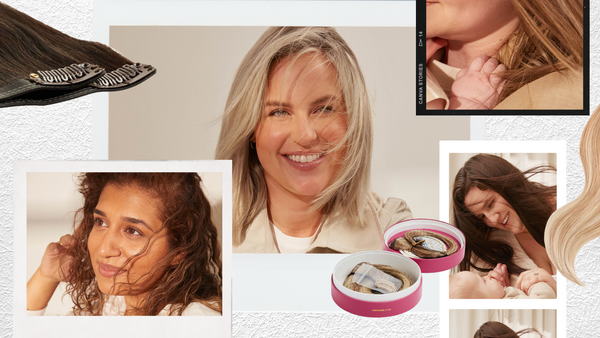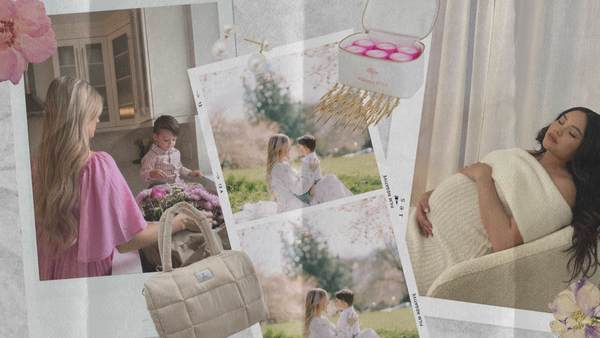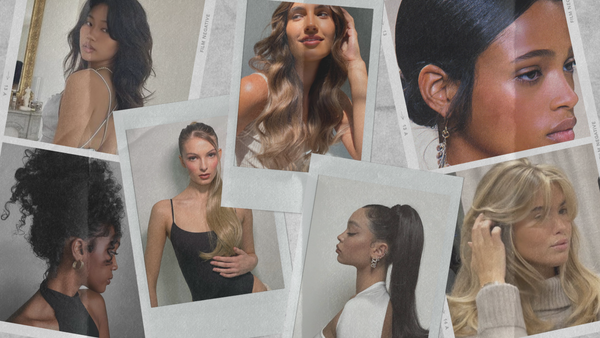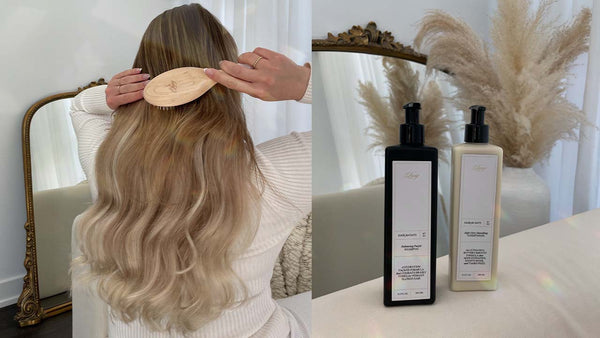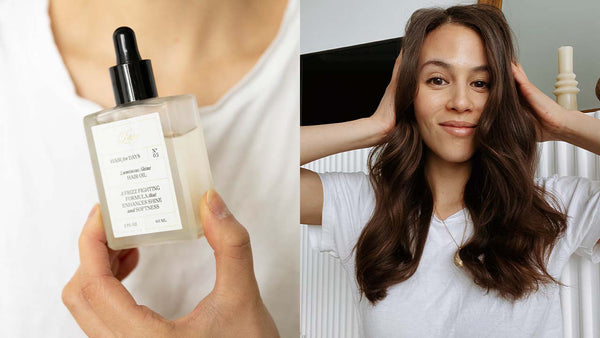We’re the first to admit that we love a good hair color switch-up. Whether it's an on-trend rose gold hue or just some subtle highlights throughout, nothing says new me more than a new do. Sometimes, however, it’s best to put down the bottle and give your hair a breather, and this step can always be a tricky one.
Being in quarantine also means an automatic pause on hair dyeing and other beauty routines as hair and nail salons remain closed. If you have highlights or were looking to go back to your natural hair color for the spring, you may have come to realization that you're going to have to grow out your hair color all on your own, without your trusty colorist to guide the way. No problem though, that's why we're here.

When it’s time to stop
The benefits of ditching the dye are pretty much endless because no matter whether you’re bleaching or coloring your hair, strands will suffer. The chemicals in hair dyes will dry your hair out and cause it to be brittle and prone to breakage—not quite the glossy locks we’re all after.
Whilst regular visits to the salon and repair masks will help lock in moisture, eventually, the only way to really solve your haircare problems will be to go au naturale. So if you’re finding that no matter how many masks you try and inches you trim that your hair is still looking lacklustre, it may be time to go back to your natural hue.
The good news? Going back to your natural hair color will do wonders for your pocketbook and hair health. No longer with you have to slather your scalp in harsh chemicals and fork over good money for the privilege. And don't worry. If you live in fear of that awkward transition phase, we have you covered. Here are some tips on how to successfully navigate your color change and come out of quarantine with a whole new hair color.
Before you embark on any drastic hair color change, it is important to do a few key things first. You need to begin by developing a plan and preparing yourself for a transition phase, and ensuring that you possess realistic expectations. Remember, Rome was not built in a day. And, your return to your natural hue will take time as well.

Get Planning
The biggest mistake you can make when reverting to your natural hair color is to pick a shade that you think looks how your natural color used to and just slapping it on. If you want to gracefully ditch the dye, it’s going to be a fairly long process that takes a decent amount of planning. Don’t dive headfirst into a world of coloring. Instead take baby steps and listen to the experts.
Work alongside a colorist to find out the best process, and be sure to let them know your entire hair history so they can know exactly what your hair has been through. That spontaneous moment when you bleached your entire hair five years ago really does matter. With a colorist you can plan the route, and while it may take a few salon visits, it’ll be worth that extra time to ensure minimal damage to your hair and top notch results.
How to grow out highlights
If you have been highlighting your hair for years and want to break the habit, there is good news. You can grow out highlights with very little effort at all!
Begin by letting your hair grow for a few months until much of your natural shade has returned. Remember, your natural shade may have changed over the years, so don't assume that you know exactly what it is, particularly if you have been adding highlights for eons. It is also recommended that you get your ends trimmed to remove all of your split and over-processed bits—while you can't make it to the salon, skip this bit until things are back to normal. In a few months, your highlights will gradually grow out and you will be left with a much healthier mane in your natural hue. Easy, right?

If your highlights start at the top of your scalp or you simply don't have the patience to grow them out, you do have another option. Garnier offers that you could opt to introduce lowlights in a shade closer to your natural color every 8 weeks until the highlights are completely gone.
Are your highlights drastically lighter than your natural hue? If so, plan to visit your colorist for a tint back—otherwise known as filling or re-pigmenting. This is when color is applied to your hair to restore the lost pigments that make up your desired darker shade. It sounds like a complicated process, but your trusted hair professional will know exactly what to do.
Do you love your highlights but hate the effort and expense involved in maintaining them? Well, you don't have to kiss your beloved splashes of light goodbye. You can, instead, use lighter colored hair extensions to create the exact same effect. If you aren't sure if your current highlight hue is the right one for you, you will want to check out this handy guide to choosing the best highlights for your undertones.
 Seamless Dirty Blonde Highlights Luxy Hair extensions
Seamless Dirty Blonde Highlights Luxy Hair extensions
Bye Bye Balayage, Adios Ombré
One of the nicest things about balayage is the fact that you can grow it out naturally and look great in the process. Why? Royal and celebrity hairdresser, Richard Ward, explains that there are no strong re-growth lines, making it grow out beautifully. Furthermore, little maintenance is required as the color doesn't start at the roots.
Once you have a grown out balayage, you may miss it. If you really love your balayage look, but want to avoid chemicals and repeated hair salon visits, you can achieve the same style with balayage hair extensions.
 Blonde Balayage, Dirty Blonde Highlights Luxy Hair Extensions
Blonde Balayage, Dirty Blonde Highlights Luxy Hair Extensions
Ombré is another easy-to-grow-out style due to its natural transition from one hue to another. Simply let it grow out and maintain regular trimmings. And here's some good news. It has been said that ombré can even look better the more it grows out, creating the appearance of naturally sun-kissed ends. If you really want a drastic change, you may even be able to have the ombré cut out and rock a shorter hairstyle.
Going back to your natural hair color
If you have been sporting a shade that is a huge departure from your natural hue, don't dismay. There are ways to make the transition from light to dark and vice versa without resorting to lopping it all off.
How to grow out bleached hair
Have you grown weary of maintaining fair locks? Keeping up platinum blonde or other equally light shades can be a tedious endeavor, especially when your natural hair color is dark. You do have options, however, that will enable you to kick the dyeing habit and embrace the color God gave you.
For this one, you may want to wait until you have access to a hair salon before going the full mile, as it is extremely important that you discuss how to dye bleached hair back to your natural hair color with an experienced professional.
After all, you cannot simply dye over pale blonde hair. In fact, you can expect it to take four coats of color for your follicles to absorb the darker shade. If you do opt to go this route, it is important to realize that the sudden switch from light blonde to dark brown may be a shock to both you and those around you.
Should you decide to go for a more gradual change, you could add some lowlights closer to your natural dark color. Another option is to add shadow roots—a technique that stretches dye naturally from your roots to the tips of your hair. Ideally, that dye should be as close to your natural hair color as possible. This enables you to grow out your hair color easily while remaining on trend. The good news? While waiting for your salon to open, your hair will gradually grow out, adopting a shadow root all on its own. Own it, rock it, and pretend you meant for your hair to look this way.
The best way to reverse the bleach is by applying an all over dye in a color just a few shades darker. Start with a natural caramel blonde shade, then at the next treatment go darker again. Repeat until you’ve got those locks you want. Using regular hair masks at each stage is crucial if you want to add hydration and softness back to your damaged hair strands. Alternatively, add some lowlights to break up the color as your hair grows. This will reduce the contrast of your roots for a softer and natural look.

Another option is to simply let your light hair grow out naturally, adopting the popular ombré style. Ombré is, after all, the gradual fading of one color to another—which is exactly what happens when you're growing out hair dye. Yes, that awkward "in between" color phase will make you the epitome of fashionable and make your dark roots appear intentional.
Growing out dark roots with light hair
Do you long to shed your dark tresses and embrace your naturally fair hair? As long as you avoid a few major faux pas, you will be able to pull this off without a problem. Begin by stepping away from the bleach. And don't even think about reaching for a bottle of light blonde hair dye. If you aren't interested in simply letting it grow out, you will need the assistance of a trusted hair professional. Remember, reaching for the dye bottle could leave your hair looking patchy and could potentially make your hair turn green.

Your stylist may wish to introduce a color that is lighter than your dyed color, but darker than your natural shade and temper it with a few highlights until your transition is complete. Another option is to have them lift the dark hue with a color remover. If you can't make it to a salon, hoewever, master hair colorist at New York's Eddie Arthur Salon, Stephanie Brown, recommends simply letting the hair grow in and adding highlights every few months until you reach your color goal.
If you're currently stuck at home, can't make it to the hair salon and want to avoid the addition of more chemicals completely, you can opt to sport the reverse balayage—a hot new trend that will enable you to grow out your color naturally. The reverse balayage graduates from light roots to darker tips. Streeters hairstylist, Tina Outen, offers that as your blonde roots grow in the darker hair will continue to grow out at the ends, or get chopped off during a trim. And, once you have a grown out balayage, you can reclaim the look without re-adding dark dye. By simply using hair extensions, you can keep up your reverse balayage without ever visiting a salon.
You may also opt for the reverse ombré while growing out your locks. This style turns the traditional ombré upside down, graduating from light on top to dark ends. This en point style will enable you to navigate your color change while looking great.
 Dark Brown, Chestnut Brown, Dirty Blonde Highlights Luxy Hair Extensions
Dark Brown, Chestnut Brown, Dirty Blonde Highlights Luxy Hair Extensions
How to grow out hair colors not found in nature
If you're the adventurous type, you may have dyed your hair a bright candy-colored hue. While lemon yellow, hot pink, or Smurf-blue locks can be fun, they get old quickly. While you may be tempted to simply erase your vibrant shade by dying over it, the results could be disastrous, especially if you had to use bleach to get your hair to hold your color in the first place.
It is best to call in the professionals for this one, and let the hair grow out while isolating. Once you are able to make it to a salon, with the right color extractors, they can pull out a lot of that rainbow hue, making it much easier to cover. If you have an abundance of patience, you can wait for the hair color to fade out and, then, dye your hair back to its natural color. You may also want to add in some highlights and lowlights to add back the depth to your locks. To restore shine and vibrancy, apply an oil treatment or gloss to your hair.

If you wish to grow out highlights, dye bleached hair back to its natural color, or grow out balayage, we have complete faith in your success while at home. By formulating a plan and exercising a wee bit of patience, you can enjoy a painless transition from chemically-treated follicles to a healthy, natural head of hair. Remember, you can always give your colorist a call or schedule a FaceTime appointment for some advice on how to tackle your hair growth. Be sure to pay them for a regular consultation, however, as many hairstylists are currently out of work. There is no better time to embrace your natural hair than right now.
Whether your natural hair is sun-soaked blonde, fiery red, or flawless mahogany, embrace the color your mane is meant to be. It's chemical free. It's inexpensive. And, it's beautiful.
Written by: Kimberley Laws
